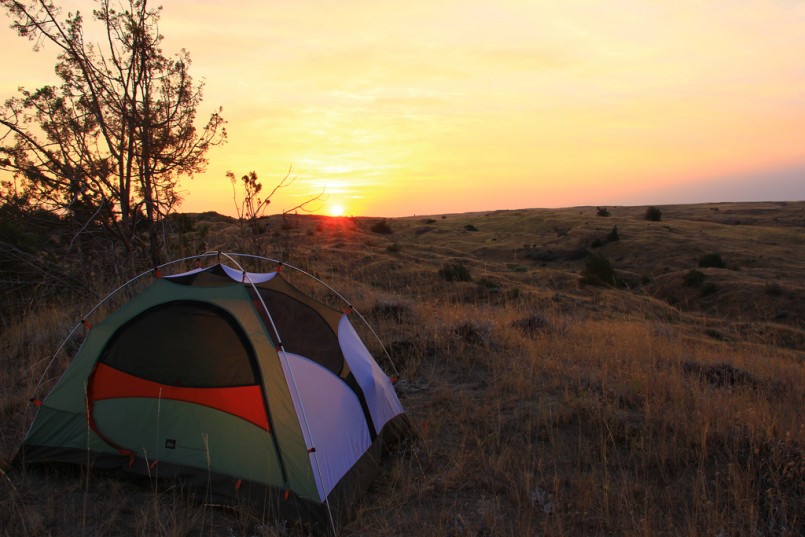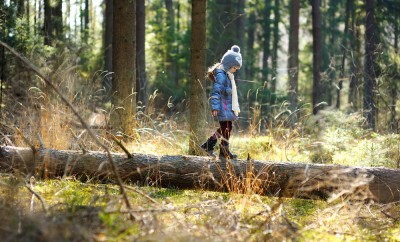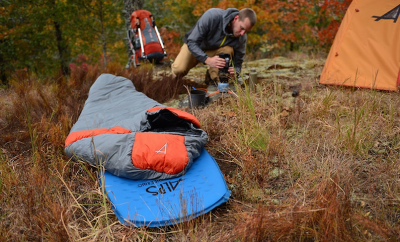Family camping tents come in many shapes and sizes. The one that suits your needs may not be the right one for someone else. That’s why there is such a large variety produced for the outdoor enthusiast market.
Shaping Up Your Tent ChoicesTents come in four basic shapes: A-frame, umbrella, geodesic or “dome”, and wall. The A-frame is the old-style, traditional “pup” tent shape, but can also be quite large. The umbrella is a commonly used family tent, with plenty of standing room, including large windows and a rain fly. The geodesic dome has many variations, with varying combinations of connected triangles. The wall tent is like an A-frame tent, but is generally much larger and has vertical side walls, and is most commonly used in army applications and Scout camps (These are usually set up on permanent decks).
Tents with square floor shapes are more efficient when laying out sleeping and gear arrangements. If you decide to purchase a tent with a round or oval floor, you should plan some extra floor space to compensate for the less efficient layout.
Size DOES MatterTents are marketed as two man, four man, six man, etc. At best this describes the most people you can cram into the tent for sleeping, with no storage for any of your personal items. This size determination is okay for backpackers who are packing light, but makes no sense for the average camper.
Why be shoe-horned into your tent? Figure on using the tent at half its rated capacity and you should have enough room for two adults and most of their gear. Each person should have a minimum of 24 square feet of floor space; enough room for your pad, sleeping bag and gear. If you are packing for a long trip, you may want to increase the square footage depending on the quantity of gear you are going to bring.
Don’t forget to purchase a tent that will be wide/long enough for you to stretch out when you sleep… a 6′ tall sleeper will be very cramped in a 6′ wide tent; leave yourself at least 1 foot of foot-room. You will need a minimum of 30″ of space across the tent for each sleeping bag just for sleeping.
Adding ‘dry’ storage for your gear, and enough space to get out of your tent without tramping on your tent companion, will result in a more enjoyable outdoor experience. With this in mind, an 8′ x 8′ tent would work well as a 2 man family tent. This gives each camper 32 square feet to spread out their gear and sleeping area. BUT, a 10′ x 10′ tent is much more suited for two adults (seems like overkill, huh?). This size tent will have enough space for air mattresses, cots or pads AND still have enough space to stand up when changing clothes.
Be careful about buying a tent larger than 10′ x 10′. First, finding a suitable place to pitch such a large item will be a challenge. You need a spot as level as possible. Second, big tents are extremely heavy and bulky to carry. Finally, it might be better to have several smaller tents so everyone isn’t sharing the same sleeping, changing & living area.
The peak height is very important to your comfort. For most trips, try to have a tent that is tall enough to stand in. Plan for the taller persons in your group. A six or seven foot peak height is necessary for adults, and a four foot peak is about right for kids. Remember, the tent slopes downward at a sharp angle, so the actual spot where you can stand up will be small. Larger spaces will be provided in tents with taller peaks.
Kids can fit comfortably in smaller tents. Once they are old enough, about seven or eight, they will probably want to sleep in a separate tent anyway. Parents will appreciate the privacy provided by this arrangement too. A five by seven foot tent is adequate for young kind. Teenagers should be considered as adults when fitting a tent.
Support Your Local Tent – PolesPoles included with most tents available today are made from aluminum or fiberglas. The better quality tents usually come with specially made aluminum poles, with a high degree of flexibility. Fiberglas poles are included in most ‘every day camping’ tents. The poles are usually linked together with an elastic shock cord. This speeds up the setting up process (important when doing it in the rain!). Poles, when mishandled can bend or break, so many tent manufacturers provide repair kits for you to carry along on the trip.
Seams to Me It’s ImportantSeams should be reinforced with nylon tape and double-stitched. The tape is stitched into each seam, which reinforces the seam and adds to the weather-proofing. All waterproof seams in on the fly and floor (or tub), are usually factory waterproofed with a seam sealer. Set up the tent in your yard before the first tent use to test out the pitching process. You can also use this opportunity to go to your local sporting goods store to buy some seam sealer and waterproofing spray. It’s always a good idea to do this to ensure a dry trip. Make sure you allow the tent to dry before packing it back up.
FabricAlmost all modern tents are now made of nylon. Coated nylon is used for waterproofing. Nylon mesh is used for inner walls and gear pockets. No-see-um mesh is used for the window screens. Better tents use thicker fabric and rip-stop fabric.
Hey!!! Zip It Up!!Make sure when you go out to buy your tent… test the zippers. They should open and close with ease and shouldn’t catch on the tent fabric. The zippers should be rust-resistant.
Hot and Cold Flashes and “Why is My Tent Shaking?”Weather variations will place many demands on your tent.
Windy conditions will call for strong poles, stakes and anchor ropes. Dome tents perform extremely in wind. Their rounded design reduces the wind’s effect, and their pole arrangement provides great strength.
Rain causes two issues to surface. Keeping yourself and your gear dry is first and foremost. Second, you need enough room for all tent occupants to be comfortable if ‘weathering the storm’ becomes necessary.
The floor should be constructed of waterproof coated nylon covering the floor, and turning up the sides for approximately six inches, creating the tub. There should be a minimal amount of seam (the more you have, the more potential for leaks). It will keep out any water that runs down and under the tent.
Make sure your tent has a waterproof rain fly made of coated nylon. The fly should wrap around the tent and reach down the sides, leaving only a few inches of space between it and the ground. This should shut out the rain, even in windy conditions. The fly should extend far enough over the door, so it keeps out the rain when you open the door to enter or leave. Some tents even come with a vestibule that allows for this.
Sunlight and its accompanying heat create a major need for shade and airflow. The rain fly will provide shade. Screen windows on opposite sides of the tent, or a screened window opposite a screened door, will allow air to flow through the tent.
Long excursions in cold weather call for a special, heavy-duty 4 season tent. Unless you plan on doing winter camping, you can use a “three-season” tent that has the features mentioned above. The most important features will be a rain fly that fully covers the top and sides to keep snow and other precipitation at bay, and an interior layer made from an open mesh fabric to allow water vapor to breathe out of the tent. In cooler weather, water vapor inside the tent from moist, outside air and exhaled breath from the occupants will condense on the interior surface of the tent. This can be prevented by allowing airflow through your tent or by passing through the mesh fabric.
The tent size is also a consideration with cool weather camping. A smaller tent will stay much warmer than a larger tent with your body heat.
You Get What You Pay ForUsually, the more expensive tents are made with stronger fabric, poles, and stitching. They’re built to withstand stronger wind and more violent rain. A good tent, that is well cared for, can last for many years.
Remember that not everyone will need this amount of durability. The milder the weather you camp in, and the closer to home you camp, the better solution will most likely be a less expensive tents.
If you’re just beginning your camping journey, and don’t know if you’ll enjoy it, you might want to start with a less expensive setup. Your first trips will probably be when the weather is warmer, and you will probably not venture deep into the wilderness until you gain some experience and decide if you like camping or not. Remember, you can always upgrade your equipment later.
For more information you can visit us at Birdseye Outdoor Supply where you can more tips to help you with your camping needs.






0 comments